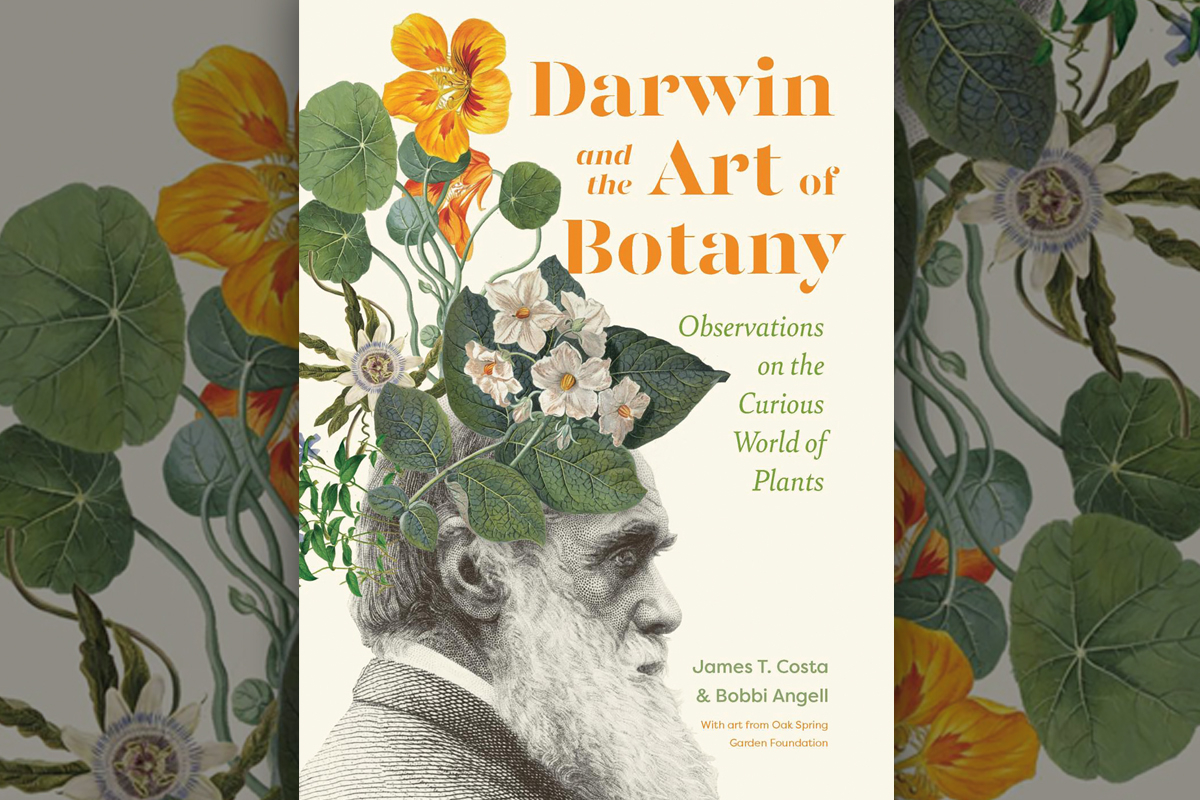Where art and science meet: ‘Darwin and the Art of Botany’

Charles Darwin was many things, but in the classic sense of the word, he was not an artist. Lacking in the ways of visual art, and with miserably bad handwriting, the scientist eventually enlisted the help of his sons in creating utilitarian illustrations of the plants and animals with which he worked.
However, a new book by James Costa and Bobbi Angell, “Darwin and the Art of Botany,” seeks to infuse Darwin’s work on plants with breathtaking and historically significant botanical illustrations of his day and bridge the oft-perceived gap between arts and sciences.
Bobbi Angell is a scientific illustrator, printmaker, instructor and gardener with more than 40 years of experience in the field. Drawing for botanists at the New York Botanical Gardens and other institutions, Angell has illustrated floras, monographs and new species. Her pen and ink line drawings have depicted several thousand species from areas as diverse as the deserts of the Intermountain West to the tropical forests of Central French Guiana and Greater Antilles. Her projects include lichens of Ohio and the Great Smokies and field guides to vines and climbing plants of Puerto Rico, the wildflowers of Pine Barrens in New Jersey and the Jura mountains of Switzerland.
Over her years of creating botanical illustrations, Angell took a particular interest in climbing plants and vines, which in turn led her to Darwin’s book “Climbing Plants.”
“I was disappointed he had not added beautiful art in the book,” Angell said of Darwin’s work on climbing plants. “I’d gone to Oak Spring Garden Foundation and saw so many beautiful paintings in Darwin’s era and thought it’d be fun to add paintings to Darwin’s chapters of climbers.”
This became the instigating factor for “Darwin and the Art of Botany,” the urge to marry the expansive botanical art of Darwin’s day with his lesser known, but no less expansive work on plant science. After enlisting Costa, a Darwin scholar, for the project and approaching Timber Press, the idea eventually grew from just climbing plants to include examples from all six of Darwin’s books on plants.
Related Items
“I read through all those books to select 45 chapters,” Angell said.
Evolutionary biologist, entomologist and historian of science, Costa is a professor of biology and executive director of Western Carolina University’s Highlands Biological Station where he teaches courses on biogeography, Darwin’s “Origin of Species” and a comparative temperate-tropical ecology field course between Highlands Biological Station and Wildsummaco Biological Station in Ecuador.

James Costa. File photo
Costa has written extensively on Darwin, as well as Alfred Russell Wallace, renowned scientific traveler, founder of evolutionary biogeography and co-discoverer with Darwin of the principle of natural selection. In addition to many academic papers and magazine articles, he has published several books on Darwin and Wallace, including “The Annotated Origin,” and “Darwin’s Backyard: How Small Experiments Led to a Big Theory.”
Darwin is perhaps best known for his work on the theory of natural selection, epitomized in his seminal work “On the Origin of Species,” which is associated with exotic animal species. “Darwin and the Art of Botany,” in addition to infusing Darwin’s work with botanical illustrations, also aims to highlight Darwin’s contributions to botanical research and exploration.
“Different animal groups became icons associated with Darwin, but ironically, he didn’t necessarily come readily to his insights simply through animals,” said Costa. “They’re iconic, but in a way, not as important as one might assume. And yet the plants, which he had entire volumes dedicated to, were the go-to model group to test these evolutionary questions. But people don’t always connect with plants in an emotional way the way they do with animals.”
Six of the 12 books Darwin wrote and published after “On the Origin of Species” dealt solely with plants, along with approximately 75 research papers. The very first book to follow “Origin” was one on orchid pollination mechanisms.
“How odd, some thought, to follow so sweeping a book as ‘Origin’ with one so narrowly focused,” Costa writes in the book. “But there was a method to the madness: the orchid book signaled the direction his work would take for the next twenty years — a corpus of work that was ‘Origin’ writ large, myriad subjects with an eye to extending and reinforcing the explanatory power of his theory.”
Of the book on orchids, Darwin himself wrote to his friend and collaborator Asa Gray, “you are the very best: no one else has perceived that my chief interest in my orchid book, has been that it was a flank movement on the enemy … It bears on design — that endless question.”
Among his many contributions to the field of botany was Darwin’s coining of the term “circumnutation” for the elliptical movement of plant tendrils and growing shoots, as well as the discovery that heterostyly, a genetic polymorphism between individual plants of the same species, serves to promote outcrossing.
In addition to orchids, Darwin explored cross and self-fertilization, variation, pollination and forms of flowers; climbing plants; insectivorous plants; and plant movement. The new book from Angell and Costa draws on each of these subjects.
The book is split up into 45 chapters on 45 different plants that Darwin spent time studying. Each chapter includes a botanical illustration of the plant in question along with an excerpt of Darwin’s own writing chosen to display his working method and depth of investigation. Alongside Darwin’s writing are explanatory passages by Costa that help to situate the reader and contextualize Darwin’s sometimes dense, technical language.
“If you read the Darwin excerpts in this book, these can be pretty dense,” said Costa. “Even Darwin made fun of himself about these books, and he said that they’re ‘dry as dirt,’ and they’re ‘good for doorstops,’ but they serve the purpose of answering questions in science.”
Flowers and plants have long been the focus of artistic and aesthetic expressions in cultures around the world. But scientifically accurate, botanical illustrations began to flourish during the Renaissance when there was a renewed focus on the medicinal qualities of plants.
The art form was further refined in the seventeenth century as Europeans, especially Spanish, Dutch and French, began exploring the globe, returning with foreign species and creating a new demand for exotic plants across the gardens of the continent. This interest only grew as Britain expanded its own colonial holdings throughout the 18th and 19th centuries.
Advancements in print-making technology, combined with demand for botanical illustrations meant that the art form reached its peak during Darwin’s lifetime.
In creating this book, Angell was curious to see what botanical paintings would have been available during Darwin’s time and undertook the task of sifting through troves of artwork at the Oak Spring Garden Foundation, among other sites.

Bobbi Angell. File photo
“In the spirit of encouraging an appreciation of the art of Darwin’s botanical science, it is appropriate to also encourage an appreciation of his subjects and of botanical art itself,” the authors wrote in the book’s introduction. “Drawing upon the stunning botanical painting and print collection of Oak Spring Garden Foundation, we bring these complementary art forms together here for modern readers.”
The Oak Spring Garden Foundation is the estate of the late Bunny Mellon, a talented garden designer and horticulturist as well as a voracious reader and collector of the history of science, botany, horticulture and art.
Today, her library and collections are open to scholars and the estate contains one of the largest and most comprehensive collections of botanical art in the world.
“They very graciously let us use all the artwork we wanted to use for this project,” said Costa.
In choosing artwork for the book, Angell took into consideration not only the quality and aesthetic of each piece, but also the historical significance.
For instance, the chapter on the North Carolina native Venus Fly Trap contains a copy of the original drawing of the plant by botanist John Ellis, which he sent in a letter to Carl Linnaeus, the father of modern taxonomy. That original is located at the Oak Spring Garden Foundation.
But the intersection of art and science displayed in the book goes beyond the selection of botanical illustrations from the time that portray the plants Darwin was studying at his home-turned-field-station just south of London.
The book and its authors seek to assert a deeper message about the place where science and art meet, one that places Darwin firmly among the creative minds of his day, one that grants Darwin a title few may have ever bestowed on him — that of an artist.
“The two spheres, they’re creative in their ways,” said Costa. “There’s certainly creativity that goes into any kind of artistic composition. But science, there’s a method to it — learning how to ask a question, a scientific question, which ideally then is going to be a testable question. I think I’ve long admired scientists that could think very creatively, often there’s sort of an elegance in the simplicity.”
Costa asserts that the simplicity and elegance of Darwin’s experiments constitute a type of art.
“There is a kind of art and a beauty in the scientific method beyond just the beauty of the organisms,” Costa said. “There is, after all, an art to science — beauty in theory, elegance in experimental design, a satisfying harmony in the consilient resonance of supporting evidence.
The authors write that they “hope [this book] fosters an appreciation of the beauty of some of Darwin’s favorite plants as well as the beauty of the scientific insights they yielded in the admiring hands of that inveterate ‘experimentiser.’”









